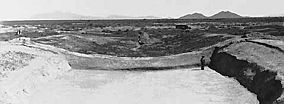Hohokam Pima National Monument facts for kids
Quick facts for kids Hohokam Pima National Monument |
|
|---|---|

Excavated ballcourt(?) at Snaketown, 1935 photo. It has since been backfilled.
|
|
| Location | Gila River Indian Reservation, Arizona |
| Area | 1,690 acres (6.8 km2) |
| Authorized | October 21, 1972 |
| Owner | Gila River Indian Community |
| Website | Hohokam Pima National Monument |
| Official name: Snaketown | |
| Designated: | April 29, 1964 |
| Designated: | July 19, 1974 |
| Reference #: | 74002221 |
The Hohokam Pima National Monument protects an ancient village called Snaketown. This important archaeological site is located within the Gila River Indian Community in Arizona. It's about 30 miles (48 km) southeast of Phoenix, Arizona.
Snaketown was named a National Historic Landmark in 1964. Later, in 1972, it became a National Monument. This gave it even more protection. The site is owned by the Gila River Indian Community. They have decided to keep the area closed to the public to protect it. You can see some artifacts from Snaketown at the museum in the nearby Casa Grande Ruins National Monument.
Contents
Life in Ancient Snaketown
The Snaketown site was likely lived in from about 300 BCE to 1200 CE. The word "Hohokam" comes from the O’odham language. It means "those who have gone." The Hohokam people were skilled farmers. They lived in a dry area with sandy soil and slow rivers.
Farming and Water Canals
The Hohokam grew crops like beans, squash, tobacco, cotton, and corn. They made the dry soil fertile by building many canals. These canals brought water from the local river to their fields. They used woven mats as small dams to guide the water. The canals were usually shallow and wide. Some of them reached up to ten miles (16 km) long.
Hohokam Homes
Most people lived in homes called pit houses. These were carefully dug rectangular holes in the ground. Their walls were made of branches and mud, supported by strong log posts. These pit houses were similar to those built by the Mogollon people. However, Hohokam pit houses were larger and had shallower foundations.
Community Life and Structures
Snaketown was a large settlement, possibly covering 250 acres (101 hectares). It might have had between 1,000 and 3,000 people living there. Families likely owned plots of land. People who helped build the canals might have gotten the best land first. The community probably owned the water, sharing it among everyone.
The village had a central plaza. It also had two large oval-shaped fields. When they were first found, archaeologists thought these were ballcourts. Each was about 60 meters (200 ft) long. However, some experts now think these fields were actually dance floors. They might have been used for ceremonies like the Vikita by the Tohono O'odham people.
The Hohokam were also good at making pottery. They made a special type of pottery called "red-on-buff." This pottery is found over a very large area. This shows how widespread and important the Hohokam people were.
Discovering Snaketown's Past
Archaeologists have studied Snaketown to learn about the Hohokam people. The site is named "Snaketown" from another O’odham word. This word means "place of snakes."
Early Excavations
The first major dig at Snaketown happened in 1934. It was led by Harold S. Gladwin and the Gila Pueblo Archaeological Foundation. Later, from 1964 to 1965, Emil Haury led a second big excavation. These teams found more than sixty midden mounds, which are ancient trash heaps. These trash heaps were very helpful. They allowed archaeologists to figure out the timeline of the site.
They also found the central plaza and the oval fields. They confirmed the complex irrigation system. The Hohokam people practiced cremation. Archaeologists found areas that might have been used for this.
Trade and Craftsmanship
The Hohokam were also skilled craftspeople. They made pottery and jewellery from shells. They traded with other societies, including those in Mesoamerica. Evidence of this trade includes copper bells and figurines found at Snaketown.
Protecting the Site
Most of the excavated areas at Snaketown have been filled back in. This helps protect the site for future research. You can see a model of the original Snaketown community at the Heard Museum in Phoenix. Artifacts from the digs are kept at the Arizona State Museum.
Why Snaketown Was Left Behind
It's not completely clear why Snaketown was abandoned around 1100 CE. Some experts think that too much irrigation might have made the soil less fertile. Others suggest that a period of warmer weather might have caused droughts.
The abandonment might have happened quickly. The archaeological evidence shows that many buildings were burned around the same time. After the people left, the site was not lived in again.
Snaketown's Legacy Today
In 1865, the United States Cavalry set up Camp McDowell near Snaketown. A few years later, in 1867, a retired soldier started an irrigation company. He used the remains of the ancient Hohokam canals. As this company grew, a new settlement formed. This settlement was eventually named "Phoenix." It was named after the mythological Phoenix bird that rises from its own ashes. This is how the capital city of Arizona got its name.
Images for kids
See also
 In Spanish: Snaketown para niños
In Spanish: Snaketown para niños




